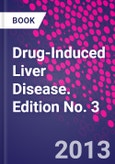This field has shown tremendous growth in recent years, primarily due to the recognition that drug-induced liver disease is the most common cause of liver failure and one of the major contributors to the withdrawal of drugs developed by the pharmaceutical industry. Drug-Induced Liver Disease, 3rd edition is a comprehensive reference that covers mechanisms of injury, diagnosis and management, major hepatotoxins, regulatory perspectives and much more. Written by highly respected authorities, this new edition is an updated and definitive reference for clinicians and scientists in academia, the pharmaceutical industry and government settings. This book contains 4 new chapters on key topics in the area and provides a current and extensive review of the latest developments concerning the toxicology, pharmacology, genetics and immunology of drug-induced liver disease.
Please Note: This is an On Demand product, delivery may take up to 11 working days after payment has been received.
Table of Contents
Part I. Mechanisms of Liver Injury Chapter 1: Drug-Induced Liver Injury: Introduction and Overview Chapter 2: Cytochrome P450 Activation of Toxins and Hepatotoxicity Chapter 3: Mechanistic Role of Acyl Glucuronides Chapter 4: Oxidative Stress, Antioxidant Defense and Liver Injury Chapter 5: Hepatotoxicity due to Mitochondrial Injury Chapter 6: Mechanisms of Cell Death and Relevance to Drug Hepatotoxicity Chapter 7: Role of Membrane Transport in Hepatotoxicity and Pathogenesis of Drug-Induced Cholestasis Chapter 8: Liver Sinusoidal Endothelial Cell and Liver Injury Chapter 9: Macrophages and Kupffer Cells in Hepatotoxicity Chapter 10: Role of Inflammation in Drug-Induced Liver Disease Chapter 11: Role of Adaptive Immune System Chapter 12: Role of Tissue Repair in Liver Injury Chapter 13: Genetic Factors in Pathogenesis
Part II. Diagnosis and Management Chapter 14: Clinical Manifestations and Management of Drug-Induced Liver Diseases Chapter 15: Histopathology of Drug-Induced Liver Disease Chapter 16: Risk Factors for Drug-Induced Liver Disease Chapter 17: The Promise of Genomics, Proteomics and Metabolomics of Blood and Liver in the Diagnosis of Drug-Induced Liver Disease Chapter 18: Causality Assessment
Part III. Hepatotoxicity of Specific Drugs Chapter 19: Mechanisms of Acetaminophen-Induced Liver Disease Chapter 20: Acetaminophen Pathology and Clinical Presentation of Hepatotoxicity Chapter 21: Mechanisms Underlying the Hepatotoxicity of Non-Steroidal Anti-Inflammatory Drugs Chapter 22: Non-Steroidal Anti-Inflammatory Drugs Pathology and Clinical Presentation of Hepatotoxicity Chapter 23: Mechanisms, Pathology and Clinical Presentation of Hepatotoxicity of Anesthetic Agents Chapter 24: Anticonvulsant AgentsChapter 25: Psychotropic Drugs and Drugs of Abuse Chapter 26: Hepatotoxicity of Antimicrobials and Antifungal Agents Chapter 27: Antituberculosis Agents Chapter 28: Hepatotoxicity in Antiviral Agents Chapter 29: Hepatotoxicity of Cardiovascular and Antidiabetic Drugs Chapter 30: Cancer Chemotherapy Chapter 31: Hepatotoxicity of Immunomodulating Agents and the Transplant Situation Chapter 32: Methotrexate Chapter 33: Hormones and Hormone Antagonists Chapter 34: Mushroom Poisoning: A Clinical Model of Toxin-Induced Centrilobular Necrosis Chapter 35: Hepatotoxicity and Herbal Medicines, Vitamins and Natural Hepatoxins Chapter 36: Occupational and Environmental Hepatotoxicity Chapter 37: Chronic Liver Disease from Drugs
Part IV. Future Directions Chapter 38: Regulatory Perspectives Chapter 39: Drug-Induced Liver Injury Networks Chapter 40: Liver Tox: The Future








